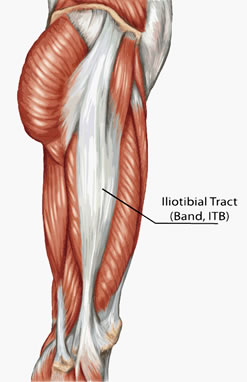Running is a thrilling way to stay fit and stave off the diseases that come with inactivity and excess weight. Unfortunately, it is hard to keep up with a running or walking schedule when you are dealing with the uncomfortable symptoms of iliotibial band syndrome. Without treatment, you may have to give up your running practice or risk permanent damage to the legs. Athletes who are concerned about interrupting their training plans may want to work on preventing the syndrome in the first place.
What is Iliotibial Band Syndrome
 The three major joints of the legs are anchored with a wide strip of ligament that runs down the outside of each limb. This is known as the iliotibial band. The ligament attaches to the hip, the knee, and the side of the shin down to the ankle. Without this band, the force of each step would cause the joints to push outward. Since this band is required for stabilization, it is easily irritated by a variety of injuries and poor running techniques.
The three major joints of the legs are anchored with a wide strip of ligament that runs down the outside of each limb. This is known as the iliotibial band. The ligament attaches to the hip, the knee, and the side of the shin down to the ankle. Without this band, the force of each step would cause the joints to push outward. Since this band is required for stabilization, it is easily irritated by a variety of injuries and poor running techniques.
Iliotibial Band Syndrome Symptoms
Start your treatment process by ruling out other causes of leg pain and similar symptoms. The signs usually associated with Iliotibial Band Syndrome include:
- Pain and burning on the outer side of either knee
- Irritation and inflammation that appears just a few minutes after you begin an activity
- Symptoms that fade with rest but return when active
- Minor to no swelling
- Diffused sensations that begin as sharp or stabbing pains
- Inflammation on the outer sides of the hip
Cause of Iliotibial Band Syndrome
There is a simple cause behind this syndrome. There is a rare chance of birth defects that affect the knee’s function, but most patients cause the problem with their behavior. The process of development usually includes:
- Excessive running, standing, walking, or other exercises that work the legs
- Inflammation to the bursa, which is a soft pad that prevents the illiotibial band from rubbing against bone
- Inadequate rest time for healing
A fall or other injury can also strain the IT band and leave it sore. This kind of trauma will usually result in pain that is constant, not just triggered by activity. If the symptoms don’t heal within a week, seek treatment to rule out more serious bone or muscle damage.
Iliotibial Band Syndrome Risks
Many runners put them selves at risk for developing these symptoms with the choices they make while training. A little education go a long way to prevent this disruptive condition, even if you are an experienced runner. Avoid practices that put you at risk like:
- Challenging runs down hills or at an angle, which puts even more pressure on the band
- Worn or incorrectly fitted running shoes
- Poor running technique that twists the leg as it strikes the grounds
- Excessive exercise without plenty of time to rest between sessions
- Insufficient stretching and warmup time
- Running on concrete without extra supportive shoes
Iliotibial Band Syndrome Treatment Options
IT band syndrome doesn’t have to keep you on the sidelines for an entire season if you seek advice and treatment when symptoms first manifest. Take a break from your daily jog and see us in New Haven for help with:
- MRI scans to determine if the tendons are swollen or enlarged
- Instruction on exercise adjustments that eliminate the irritation
- Gentle stretching to help you eliminate tension in the hip or knee
- Massage and pain management for short term injury
Support Your Fitness Routine By Managing Iliotibial Band Syndrome
Visiting our office is the quickest way to determine if you have common runner’s injury or a bigger problem. Anytime you take a fall or have pain that won’t fade with a few days of rest, you may have nerve inflammation or a hard to find fracture. Let us put your mind at ease if you do have Iliotibial Band Syndrome with noninvasive and effective treatments. To start determining the cause of your leg pain, contact us at our Fort Wayne area clinic today.


